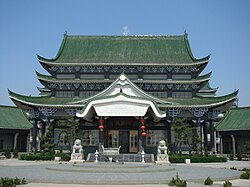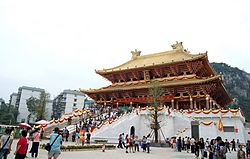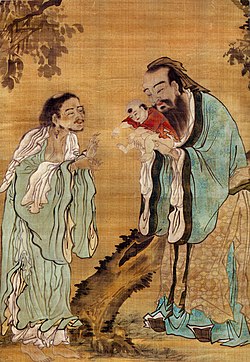
In the study of comparative religion, the East Asian religions, form a subset of the Eastern religions which originated in East Asia.

This group includes Chinese religion overall, which further includes ancestor veneration, Chinese folk religion, Confucianism, Taoism and popular salvationist organisations (such as Yiguandao and Weixinism), as well as elements drawn from Mahayana Buddhism that form the core of Chinese and East Asian Buddhism at large.[1] The group also includes Shinto and Tenrikyo of Japan, and Korean Shamanism, all of which combine shamanistic elements and indigenous ancestral worship with various influences from Chinese religions.[2] Chinese salvationist religions have influenced the rise of Japanese new religions such Tenriism and Korean Jeungsanism; as these new religious movements draw upon indigenous traditions but are heavily influenced by Chinese philosophy and theology.[3] All these religious traditions generally share core concepts of spirituality, divinity and world order, including Tao ('way') and Tian ('heaven').[4]
Early Chinese philosophies defined the Tao and advocated cultivating the de 'virtue', which arises from the knowledge of such Tao.[5] Some ancient Chinese philosophical schools merged into traditions with different names or became extinct, such as Mohism and others belonging to the ancient Hundred Schools of Thought, which were largely subsumed into Taoism. East Asian religions include many theological stances, including polytheism, nontheism, henotheism, monotheism, pantheism, panentheism and agnosticism.[6]
The place of East Asian religions among major religious groups is comparable to the Abrahamic religions found across the classical world, and Indian religions across the Indian subcontinent, Tibetan plateau and Southeast Asia.[7]
Terminology
[edit]
Despite a wide variety of terms, the traditions described as "Far Eastern religions", "East Asian religions" or "Chinese religions" are recognized by scholars as a distinct religious family.[8][9]
Syncretism is a common feature of East Asian religions, often making it difficult to recognise individual faiths.[10][11] Further complications arise from the inconsistent use of many terms. "Tao religion" is often used for Taoism itself,[12] as well as being used for many Tao-based new religious movements.[13]
"Far Eastern religion" or "Taoic religion" may refer only to faiths incorporating the concept of Tao, may include Chan and Japanese Buddhism, or may inclusively refer to all Asian religions.[14][15][16]
Religions
[edit]Taoic religion
[edit]The Tao and its virtue
[edit]The Tao may be roughly defined as the flow of reality, of the universe, or the force behind the natural order.[17] Believed to be the influence that keeps the universe balanced and ordered, the Tao is associated with nature, due to a belief that nature demonstrates the Tao.[18] It is often considered to be the source of both existence and non-existence.[19]
The Tao is often associated with a "virtue" of being, the de or te. This is considered the active expression of Tao.[20] Generally, those religions closer to Taoism explain de as "integrity" or "wholeness", while those faiths closer to Confucianism express this concept as "morality" or "sound character".[21]
Taoism and Confucianism
[edit]The concepts of Tao and de are shared by both Taoism and Confucianism.[22] The authorship of the Tao Te Ching, the central book of Taoism, is assigned to Laozi, who is traditionally held to have been a teacher of Confucius.[23] However, some scholars believe that the Tao Te Ching arose as a reaction to Confucianism.[24] Zhuangzi, reacting to the Confucian-Mohist ethical disputes casts Laozi as a prior step to the Mohists by name and the Confucians by implication. However, secular scholars usually consider Laozi and Zhuangzi to have been mythological figures.[25][26]
Early Taoist texts reject Confucian emphasis on rituals and order, in favour of an emphasis on "wild" nature and individualism. Historical Taoists challenged conventional morality, while Confucians considered society debased and in need of strong ethical guidance.[27]
Taoism
[edit]
Taoism consists of a wide variety of religious, philosophical and ritual orders.[28] There are hermeneutic (interpretive) difficulties in the categorisation of Taoist schools, sects and movements.[29]
Taoism does not fall strictly under an umbrella or a definition of an organised religion like the Abrahamic traditions, nor can it purely be studied as a variant of Chinese folk religion, as much of the traditional religion is outside of the tenets and core teachings of Taoism. Robinet asserts that Taoism is better understood as a way of life than as a religion, and that its adherents do not approach or view Taoism the way non-Taoist historians have done.[30]
In general, Taoist propriety and ethics place an emphasis on the unity of the universe, the unity of the material world and the spiritual world, the unity of the past, present and future, as well as on the Three Jewels of the Tao (love, moderation, humility).[31] Taoist theology focuses on doctrines of wu wei ("non-action"), spontaneity, relativity and emptiness.[32][33]
Traditional Chinese Taoist schools accept polytheism, but there are differences in the composition of their pantheon.[34] On the popular level, Taoism typically presents the Jade Emperor as the head deity. Professionalised Taoism (i.e. priestly orders) usually presents Laozi and the Three Pure Ones at the top of the pantheon.[35]
Worship of nature deities and ancestors is common in popular Taoism, while professional Taoists put an emphasis on internal alchemy. The Tao is never an object of worship, being treated more like the Indian concept of atman.[36]
Confucianism
[edit]
Confucianism is a complex system of moral, social, political, and religious thought, influential in the history of East Asia.[37] It is commonly associated with legalism, but actually rejects legalism for ritualism.[38] It also endorses meritocracy as the ideal of nobility.[39] Confucianism includes a complicated system governing duties and etiquette in relationships. Confucian ethics focus on familial duty, loyalty and humaneness.[40]
Confucianism recognises the existence of ancestral spirits and deities, advocating paying them proper respect.[41] Confucian thought is notable as the framework upon which the syncretic Neo-Confucianism was built.[42]
Neo-Confucianism was developed in reaction to Taoism and Chan Buddhism. It was formulated during the Song dynasty, but its roots may be traced to scholars of the Tang dynasty. It draw Buddhist religious concepts and Taoist yin yang theory, as well as the Yijing, and placed them within the framework of classic Confucianism.[43]
Despite Neo-Confucianism's incorporation of elements of Buddhism and Taoism, its apologists still decried both faiths.[44] Neo-Confucianism was an officially endorsed faith for over five centuries, deeply influencing all of East Asia.[45]
New Confucianism is a modernist Confucianism, which accommodates modern science and democratic ideals, while remaining conservative in preserving traditional Neo-Confucianist positions. The influence of New Confucianism prompted since Deng Xiaoping became the leader of China in 1978 and helped cultural exchanges between China and Taiwan.[46]
Shinto
[edit]
Shinto is the ethnic religion of Japan.[47] Shinto literally means "Way of the gods". Shinto practitioners commonly affirm tradition, family, nature, cleanliness and ritual observation as core values.[48]
Taoist influence is significant in their beliefs about nature and self-mastery. Ritual cleanliness is a central part of Shinto life.[49] Shrines have a significant place in Shinto, being places for the veneration of the kami (gods or spirits).[50] "Folk", or "popular", Shinto features an emphasis on shamanism, particularly divination, spirit possession and faith healing. "Sect" Shinto is a diverse group including mountain-worshippers and Confucian Shinto schools.[51]
Tengrism
[edit]Tengrism is the ethnic religion of Mongolia.
Interaction with Indian religions
[edit]
The entry of Buddhism into China from the Indian subcontinent was marked by interaction and syncretism with Taoism in particular.[52] Originally seen as a kind of "foreign Taoism", Buddhism's scriptures were translated into Chinese using the Taoist vocabulary.[53] Chan Buddhism was particularly modelled after Taoism, integrating distrust of scripture, text and even language, as well as the Taoist views of embracing "this life", dedicated practice and the "every-moment".[54] In the Tang period Taoism incorporated such Buddhist elements as monasteries, vegetarianism, prohibition of alcohol, the doctrine of emptiness, and collecting scripture into tripartite organisation. During the same time, Chan Buddhism grew to become the largest sect in Chinese Buddhism.[55]
The Buddha's "Dharma" seemed alien and amoral to conservative and Confucian sensibilities.[56] Confucianism promoted social stability, order, strong families, and practical living, and Chinese officials questioned how monastic lifestyle and personal attainment of enlightenment benefited the empire.[53] However, Buddhism and Confucianism eventually reconciled after centuries of conflict and assimilation.[57]
Ideological and political rivals for centuries, Taoism, Confucianism, and Buddhism deeply influenced one another.[58] They did share some similar values. All three embraced a humanist philosophy emphasising moral behavior and human perfection. In time, most Chinese people identified to some extent with all three traditions simultaneously.[59] This became institutionalised when aspects of the three schools were synthesised in the Neo-Confucian school.[57]
See also
[edit]- Buddhist ethics
- Edo Neo-Confucianism
- Religion in China
- Religion in Japan
- Religion in Korea
- Religion in Taiwan
- Shinbutsu-shūgō
- Three teachings
- Shenism
References
[edit]Citations
[edit]- ^ Kitagawa 2002, pp. 281, 292.
- ^ Schmidt, Carmen Elisabeth (2018), "Values and Democracy in East Asia and Europe: A Comparison", Asian Journal of German and European Studies, 3 (10): 4, doi:10.1186/s40856-018-0034-9, S2CID 52234364
- ^ Kitagawa 2002, pp. 325.
- ^ Kitagawa 2002, pp. 265–266, 305.
- ^ Maspero, Henri; Maspero, Henri (1981), Taoism and Chinese religion, translated by Kierman, Frank A. Jr, Amherst, MA: University of Massachusetts Press, p. 32, ISBN 978-0-870-23308-1
- ^ 中央研究院國際漢學會議論文集: 藝術史組 (in Chinese), Gaiyuan, 1981, p. 141
- ^ Sharot, Stephen (2001), A comparative sociology of world religions: virtuosos, priests, and popular religion, New York University Press, pp. 71–72, 75–76, ISBN 978-0-8147-9805-8
- ^ de Groot, J. J. M. Religion in China: Universism a Key to the Study of Taoism and Confucianism. Pp 45–46. Kessinger Publishing. 2004. ISBN 1-4179-4658-X.
- ^ James, Edwin Olver. The Comparative Study of Religions of the East (excluding Christianity and Judaism). Pg 5. University of Michigan Press. 1959.
- ^ Ito, Satoshi. Translated by Breen, John and Mark Teeuwen. Shinto – A Short History. Pg 9. Routledge. 2003. ISBN 0-415-31179-9
- ^ Fisher, Mary Pat. Living Religions: An Encyclopaedia of the World's Faiths. Pg 164. I.B. Tauris. 1997. ISBN 1-86064-148-2.
- ^ Vrijhof, Pieter Hendrik & Waardenburg, Jean Jacques. Official and Popular Religion: Analysis of a Theme for Religious Studies. Pg 419. Walter de Gruyter. 1979. ISBN 90-279-7998-7.
- ^ Beversluis, Joel Diederik. Sourcebook of the World's Religions: An Interfaith Guide to Religion and Spirituality. Pg 41. New World Library. 2000. ISBN 1-57731-121-3.
- ^ Fisher, Mary Pat. Living Religions: An Encyclopaedia of the World's Faiths. Pp 164–165, 174–175. I.B. Tauris. 1997. ISBN 1-86064-148-2.
- ^ Northrop, Filmer Stuart Cuckow. The Meeting of East and West: An Inquiry Concerning World Understanding. Pg 412. The Macmillan company. 1946.
- ^ Yamamoto, J. Isamu.Buddhism: Buddhism, Taoism and Other Far Eastern Religions. Zondervan. 1998. ISBN 0-310-48912-1.
- ^ Cane, Eulalio Paul. Harmony: Radical Taoism Gently Applied. Pg 13. Trafford Publishing, 2002. ISBN 1-4122-4778-0.
- ^ Martinson, Paul Varo A theology of world religions: Interpreting God, self, and world in Semitic, Indian, and Chinese thought. Pp 168–169. Augsburg Publishing House. 1987. ISBN 0-8066-2253-9.
- ^ See Wuji and Taiji for more information about "non-existence" and "existence" in East Asian religious thought.
- ^ Sharot, Stephen. A Comparative Sociology of World Religions: virtuosos, priests, and popular religion. Pp 77–78, 88. New York: NYU Press, 2001. ISBN 0-8147-9805-5.
- ^ Yao, Xinzhong. An Introduction to Confucianism. Pp 155–156. Cambridge University Press. 2000. ISBN 0-521-64430-5.
- ^ Markham, Ian S. & Ruparell, Tinu. Encountering Religion: an introduction to the religions of the world. Pg 254. Blackwell Publishing, 2001. ISBN 0-631-20674-4.
- ^ Hansen, Chad D. A Daoist Theory of Chinese Thought: A Philosophical Interpretation. Pp 202, 210. Oxford University Press. 2000. ISBN 0-19-513419-2.
- ^ Fisher, Mary Pat. Living Religions: An Encyclopaedia of the World's Faiths. Pg 167. I.B. Tauris. 1997. ISBN 1-86064-148-2.
- ^ Boltz, William G. "Lao tzu Tao te ching." Early Chinese Texts: A Bibliographical Guide, edited by Michael Loewe. pg 270. Berkeley: University of California, Institute of East Asian Studies. 1993. (Laozi)
- ^ Birrell, Anne. Chinese Myths. Pp 16–17. University of Texas Press. 2000. ISBN 0-292-70879-3. (Zhuangzi)
- ^ Maspero, Henri. Translated by Frank A. Kierman, Jr. Taoism and Chinese Religion. pg 39. University of Massachusetts, 1981.
- ^ Elizabeth Pollard; Clifford Rosenberg; Robert Tignor (16 December 2014). Worlds Together, Worlds Apart: A History of the World – From the Beginnings of Humankind to the Present. W.W. Norton. p. 164. ISBN 978-0-393-91847-2.
- ^ Mair (2001) p. 174
- ^ Robinet (1997), pp. 3–4, 103.
- ^ Leaman, Oliver. Key Concepts in Eastern Philosophy . Pg 111. Routledge, 1999. ISBN 0-415-17362-0.
- ^ Slingerland, Edward Gilman. Effortless Action: Wu-Wei as Conceptual Metaphor and Spiritual Ideal in Early China. Oxford University Press, 2003. ISBN 0-19-513899-6.
- ^ Sharot, Stephen. A Comparative Sociology of World Religions: virtuosos, priests, and popular religion. Pg 78. New York: NYU Press, 2001. ISBN 0-8147-9805-5.
- ^ Segal, Robert Alan. The Blackwell Companion to the Study of Religion. Pg 50. Blackwell Publishing. 2006. ISBN 0-631-23216-8.
- ^ Maspero, Henri. Translated by Frank A. Kierman, Jr. Taoism and Chinese Religion. pg 41. University of Massachusetts, 1981.
- ^ LaFargue, Michael. Tao and Method: A Reasoned Approach to the Tao Te Ching. Pg 283. SUNY Press. 1994. ISBN 0-7914-1601-1
- ^ Lin, Justin Yifu (2012). Demystifying the Chinese Economy. Cambridge University Press. p. 107. ISBN 978-0-521-19180-7.
- ^ Yao, Xinzhong. An Introduction to Confucianism. pp 191–192. Cambridge University Press. 2000. ISBN 0-521-64430-5
- ^ Smart, Ninian. World Philosophies. Pp 66. Routledge (UK). 2000. ISBN 0-415-22852-2.
- ^ De Bary, William Theodore & Tu, Weiming. Confucianism and Human Rights. Pg 149. Columbia University Press. 1998. ISBN 0-231-10936-9.
- ^ Sharot, Stephen. A Comparative Sociology of World Religions: virtuosos, priests, and popular religion. Pp 46, 85. New York: NYU Press, 2001. ISBN 0-8147-9805-5.
- ^ Huang, Siu-chi. Essentials of Neo-Confucianism: Eight Major Philosophers of the Song and Ming Periods. Pg 5. Greenwood Press, 1999. ISBN 0-313-26449-X.
- ^ Huang, Siu-chi. Essentials of Neo-Confucianism: Eight Major Philosophers of the Song and Ming Periods. Pp 11–12, 63–64, 106. Greenwood Press, 1999. ISBN 0-313-26449-X.
- ^ Maspero, Henri. Translated by Frank A. Kierman, Jr. Taoism and Chinese Religion. pg 52–53. University of Massachusetts, 1981.
- ^ Flew, Antony G. A Dictionary of Philosophy. Pg 62. St. Martin's Griffin. 1984. ISBN 0-312-20923-1.
- ^ Ruiping Fan (2011). The Renaissance of Confucianism in Contemporary China. Springer Science & Business Media. ISBN 9789400715424.
- ^ Hardacre, Helen (2017). Shinto: A History. Oxford: Oxford University Press. p. 4. ISBN 978-0-19-062171-1.
- ^ Ono, Sakyo. Shinto: The Kami Way. Pp 97–99, 103–104. Tuttle Publishing. 2004. ISBN 0-8048-3557-8
- ^ Ono, Sakyo. Shinto: The Kami Way. Pp 51–52, 108. Tuttle Publishing. 2004. ISBN 0-8048-3557-8
- ^ Markham, Ian S. & Ruparell, Tinu . Encountering Religion: an introduction to the religions of the world. pp 304–306 Blackwell Publishing, 2001. ISBN 0-631-20674-4.
- ^ Ono, Sakyo. Shinto: The Kami Way. Pg 12. Tuttle Publishing. 2004. ISBN 0-8048-3557-8
- ^ Maspero, Henri. Translated by Frank A. Kierman, Jr. Taoism and Chinese Religion. pg 46. University of Massachusetts, 1981.
- ^ a b Prebish, Charles. Buddhism: A Modern Perspective. Pg 192. Penn State Press, 1975. ISBN 0-271-01195-5.
- ^ Dumoulin, Heinrich, Heisig, James W. & Knitter, Paul. Zen Buddhism: A History (India and China). Pp 68, 70–73, 167–168. World Wisdom, Inc, 2005. ISBN 0-941532-89-5.
- ^ Dumoulin, Heinrich, Heisig, James W. & Knitter, Paul. Zen Buddhism: A History (India and China). Pp 166–167, 169–172. World Wisdom, Inc, 2005. ISBN 0-941532-89-5.
- ^ Dumoulin, Heinrich, Heisig, James W. & Knitter, Paul. Zen Buddhism: A History (India and China). Pp 189–190, 268–269. World Wisdom, Inc, 2005. ISBN 0-941532-89-5.
- ^ a b Moore, Charles Alexander. The Chinese Mind: Essentials of Chinese Philosophy and Culture. Pp 133, 147. University of Hawaii Press. 1967. ISBN 0-8248-0075-3.
- ^ Markham, Ian S. & Ruparell, Tinu . Encountering Religion: an introduction to the religions of the world. pp 248–249. Blackwell Publishing, 2001. ISBN 0-631-20674-4.
- ^ Windows on Asia Archived 2009-02-20 at the Wayback Machine Asian Studies Center, Michigan State University.
Works cited
[edit]Kitagawa, Joseph (2002), The Religious Traditions of Asia: Religion, History, and Culture, Taylor & Francis, ISBN 978-0-700-71762-0
